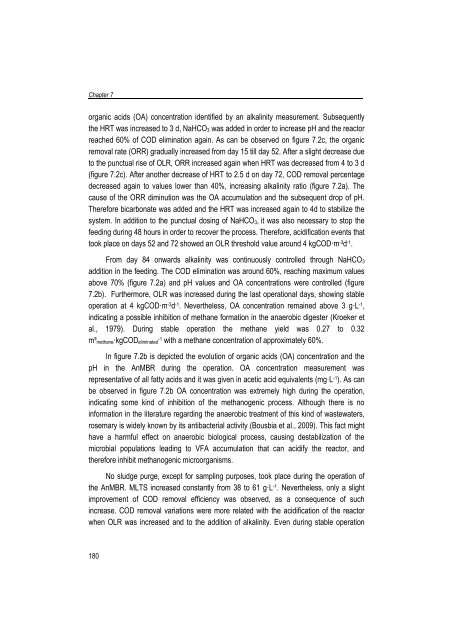Combining submerged membrane technology with anaerobic and ...
Combining submerged membrane technology with anaerobic and ...
Combining submerged membrane technology with anaerobic and ...
Create successful ePaper yourself
Turn your PDF publications into a flip-book with our unique Google optimized e-Paper software.
Chapter 7organic acids (OA) concentration identified by an alkalinity measurement. Subsequentlythe HRT was increased to 3 d, NaHCO 3 was added in order to increase pH <strong>and</strong> the reactorreached 60% of COD elimination again. As can be observed on figure 7.2c, the organicremoval rate (ORR) gradually increased from day 15 till day 52. After a slight decrease dueto the punctual rise of OLR, ORR increased again when HRT was decreased from 4 to 3 d(figure 7.2c). After another decrease of HRT to 2.5 d on day 72, COD removal percentagedecreased again to values lower than 40%, increasing alkalinity ratio (figure 7.2a). Thecause of the ORR diminution was the OA accumulation <strong>and</strong> the subsequent drop of pH.Therefore bicarbonate was added <strong>and</strong> the HRT was increased again to 4d to stabilize thesystem. In addition to the punctual dosing of NaHCO 3, it was also necessary to stop thefeeding during 48 hours in order to recover the process. Therefore, acidification events thattook place on days 52 <strong>and</strong> 72 showed an OLR threshold value around 4 kgCOD·m -3 d -1 .From day 84 onwards alkalinity was continuously controlled through NaHCO 3addition in the feeding. The COD elimination was around 60%, reaching maximum valuesabove 70% (figure 7.2a) <strong>and</strong> pH values <strong>and</strong> OA concentrations were controlled (figure7.2b). Furthermore, OLR was increased during the last operational days, showing stableoperation at 4 kgCOD·m -3 d -1 . Nevertheless, OA concentration remained above 3 g·L -1 ,indicating a possible inhibition of methane formation in the <strong>anaerobic</strong> digester (Kroeker etal., 1979). During stable operation the methane yield was 0.27 to 0.32m³ methane·kgCOD eliminated-1<strong>with</strong> a methane concentration of approximately 60%.In figure 7.2b is depicted the evolution of organic acids (OA) concentration <strong>and</strong> thepH in the AnMBR during the operation. OA concentration measurement wasrepresentative of all fatty acids <strong>and</strong> it was given in acetic acid equivalents (mg·L -1 ). As canbe observed in figure 7.2b OA concentration was extremely high during the operation,indicating some kind of inhibition of the methanogenic process. Although there is noinformation in the literature regarding the <strong>anaerobic</strong> treatment of this kind of wastewaters,rosemary is widely known by its antibacterial activity (Bousbia et al., 2009). This fact mighthave a harmful effect on <strong>anaerobic</strong> biological process, causing destabilization of themicrobial populations leading to VFA accumulation that can acidify the reactor, <strong>and</strong>therefore inhibit methanogenic microorganisms.No sludge purge, except for sampling purposes, took place during the operation ofthe AnMBR. MLTS increased constantly from 38 to 61 g·L -1 . Nevertheless, only a slightimprovement of COD removal efficiency was observed, as a consequence of suchincrease. COD removal variations were more related <strong>with</strong> the acidification of the reactorwhen OLR was increased <strong>and</strong> to the addition of alkalinity. Even during stable operation180
















